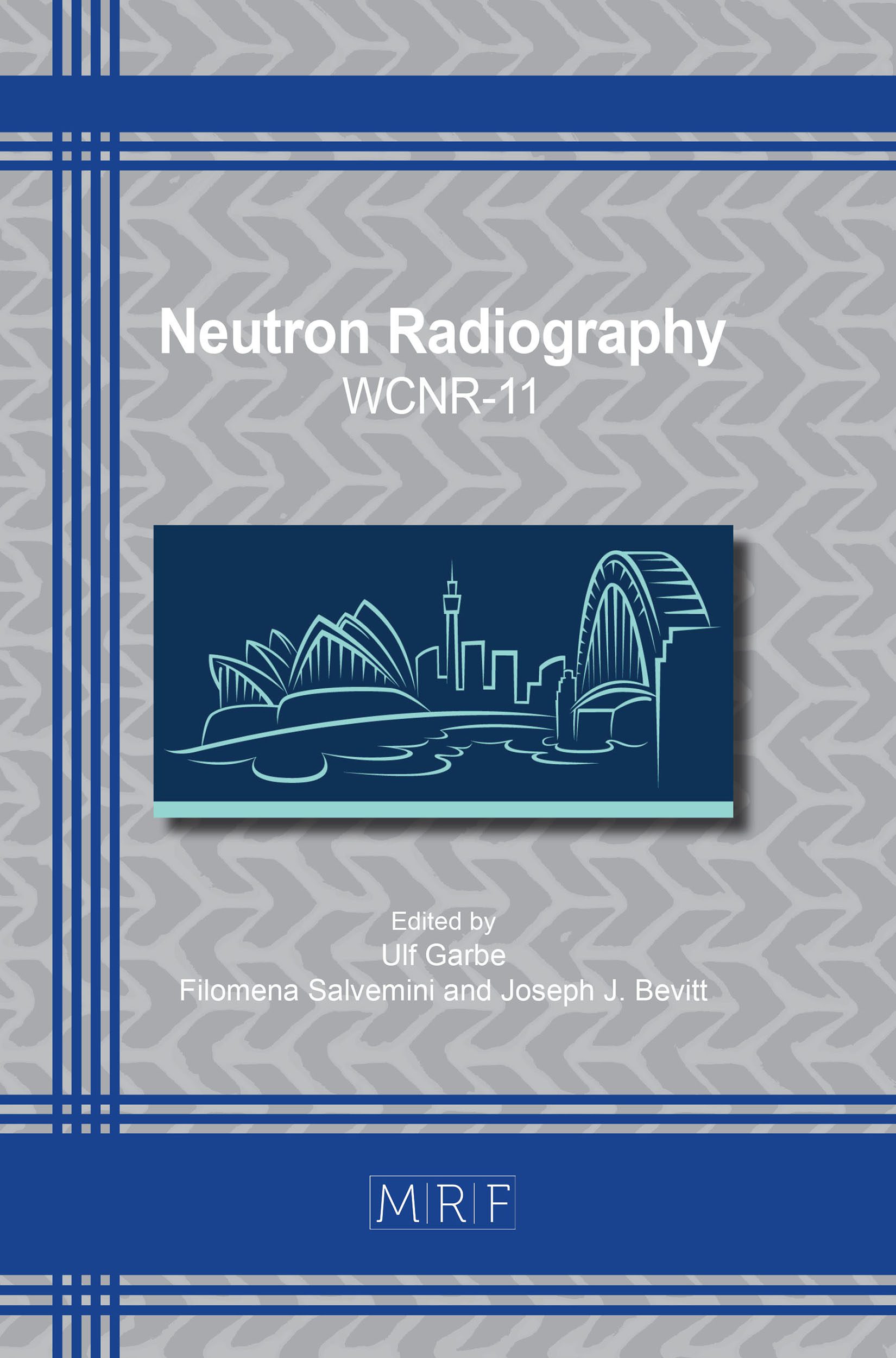Pulsed Neutron Imaging Based Crystallographic Structure Study of a Japanese Sword made by Sukemasa in the Muromachi Period
Kenichi Oikawa, Yoshiaki Kiyanagi, Hirotaka Sato, Kazuma Ohmae, Anh Hoang Pham, Kenichi Watanabe, Yoshihiro Matsumoto, Takenao Shinohara, Tetsuya Kai, Stefanus Harjo, Masato Ohnuma, Sigekazu Morito, Takuya Ohba, Akira Uritani, Masakazu Ito
download PDFAbstract. Energy-resolved neutron imaging using a pulsed neutron source is capable of visualizing crystallographic information over a large area of a sample by analyzing position-dependent Bragg-edge transmission spectra. We applied this method to a Japanese sword, signed by Sukemasa, to elucidate position dependent crystallographic characteristics, including but not limited to: degree of hardening, crystallite size, degree of preferred orientation. By comparing the degree of hardening to that of a contemporary short Japanese sword (dagger), the Sukemasa showed relatively small changes in the position of Bragg-edge (110) and its broadening. No coarse grain was found within the detector resolution (ca. 1 mm), and the crystallite size of the blade area was analyzed to be almost uniform and less than 1 m. We thus recognize in a comprehensive manner that the Sukemasa sword was manufactured with great care.
Keywords
Japanese Sword, Quench Hardening, Martensite, Bragg-Edge Transmission, RITS Code
Published online 1/5/2020, 7 pages
Copyright © 2020 by the author(s)
Published under license by Materials Research Forum LLC., Millersville PA, USA
Citation: Kenichi Oikawa, Yoshiaki Kiyanagi, Hirotaka Sato, Kazuma Ohmae, Anh Hoang Pham, Kenichi Watanabe, Yoshihiro Matsumoto, Takenao Shinohara, Tetsuya Kai, Stefanus Harjo, Masato Ohnuma, Sigekazu Morito, Takuya Ohba, Akira Uritani, Masakazu Ito, Pulsed Neutron Imaging Based Crystallographic Structure Study of a Japanese Sword made by Sukemasa in the Muromachi Period, Materials Research Proceedings, Vol. 15, pp 207-213, 2020
DOI: https://doi.org/10.21741/9781644900574-32
The article was published as article 32 of the book Neutron Radiography
![]() Content from this work may be used under the terms of the Creative Commons Attribution 3.0 licence. Any further distribution of this work must maintain attribution to the author(s) and the title of the work, journal citation and DOI.
Content from this work may be used under the terms of the Creative Commons Attribution 3.0 licence. Any further distribution of this work must maintain attribution to the author(s) and the title of the work, journal citation and DOI.
References
[1] A. Amata, T. Tsuchiko, Tetsu to Nihontō, first ed., Keiyūsha, Tōkyō, 2004 (in Japanese).
[2] T. Saito, Kinzoku ga kataru Nihonshi : senka, nihontō, teppō, first ed., Yoshikawa Kōbunkan, Tōkyō, 2012 (in Japanese).
[3] T. Takahashi, T. Murakami, S. Okada, N. Fujii, Discovering New Aspects in a Japanese Sword, Tetsu-to-Hagane 71 (1985) 108-114 (in Japanese). https://doi.org/10.2355/tetsutohagane1955.71.15_1818
[4] F. Grazzi, L. Bartoli, F. Civita, R. Franci, A. Paradowska, A. Scherillo, M. Zoppi, From Koto age to modern times: Quantitative characterization of Japanese swords with Time of Flight Neutron Diffraction, J. Anal. At. Spectrom. 26 (2011) 1030-1039. https://doi.org/10.1039/c0ja00238k
[5] F. Salvemini, F. Grazzi, S. Peetermans, F. Civita, R. Franci, S. Hartmann, E. Lehmann, M. Zoppi, Quantitative characterization of Japanese ancient swords through energy-resolved neutron imaging, J. Analytical Atomic Spectrometry 27 (2012) 1494-1501. https://doi.org/10.1039/c2ja30035d
[6] Y. Shiota, H. Hasemi, Y. Kiyanagi, Crystallographic analysis of a Japanese sword by using Bragg edge transmission spectroscopy, Phys. Procedia 88 (2017) 128-133. https://doi.org/10.1016/j.phpro.2017.06.017
[7] T. Shinohara, T. Kai, K. Oikawa, M. Segawa, M. Harada, T. Nakatani, M. Ooi, K. Aizawa, H. Sato, T. Kamiyama, H. Yokota, T. Sera, K. Mochiki, Y. Kiyanagi, Final design of the Energy-Resolved Neutron Imaging System “RADEN” at J-PARC, J. Phys. Conf. Ser. 746 (2016) 012007. https://doi.org/10.1088/1742-6596/746/1/012007
[8] S. Uno, T. Uchida, M. Sekimoto, T. Murakami, K. Miyama, M. Shoji, E. Nakano, T. Koike, K. Morita, H. Sato, T. Kamiyama, Y. Kiyanagi, Two-dimensional neutron detector with GEM and its applications, Phys. Procedia 26 (2012) 142-152. https://doi.org/10.1016/j.phpro.2012.03.019
[9] H. Sato, T. Kamiyama, Y. Kiyanagi, A Rietveld-type analysis code for pulsed neutron Bragg-edge transmission imaging and quantitative evaluation of texture and microstructure of a welded α-iron plate, Mater. Trans. 52 (2011) 1294-1302. https://doi.org/10.2320/matertrans.M2010328
[10] B. Dodd, The making of old Japanese swords, J Mech Work Tech 2 (1978) 75-84. https://doi.org/10.1016/0378-3804(78)90016-5
[11] H. Sato, T. Sato, Y. Shiota, T. Kamiyama, A.S. Tremsin, M. Ohnuma, Y. Kiyanagi, Relation between Vickers hardness and Bragg-edge broadening in quenched steel rods observed by pulsed neutron transmission imaging, Mater. Trans. 56 (2015) 1147-1152. https://doi.org/10.2320/matertrans.M2015049
[12] T. Inoue, Tatara and the Japanese sword: the science and technology, Acta Mech 214 (2010) 17-30. https://doi.org/10.1007/s00707-010-0308-7
[13] Y. Kiyanagi, H. Sato, T. Kamiyama, T. Shinohara, A new imaging method using pulsed neutron sources for visualizing structural and dynamical information, J. Phys.: Conf. Ser. 340 (2012) 012010. https://doi.org/10.1088/1742-6596/340/1/012010
[14] Y. Matsumoto, K. Watanabe, K. Ohmae, A. Uritani, Y. Kiyanagi, H. Sato, M. Ohnuma, A.H. Pham, S. Morito, T. Ohba, K. Oikawa, T. Shinohara, T. Kai, S. Harjo, M. Ito, This proceeding.































